Creating Winning Business Project: Business Model Canvas Iteration
VerifiedAdded on 2021/02/19
|11
|3005
|696
Project
AI Summary
This project focuses on developing a winning business model using the Business Model Canvas (BMC). It involves creating three versions of the BMC, reflecting on the business idea, and iterating based on feedback and testing. The project covers key aspects such as key partners, activities, value propositions, customer relationships, channels, revenue streams, cost structures, and resources. Students are required to explain their business idea, its history, and assumptions, and reflect on the development process, pitch preparation, and action learning set. The project also includes testing assumptions, analyzing competitor insights, and understanding the iterative journey of refining the business model. The goal is to provide a comprehensive understanding of the BMC and its practical application in developing a successful business venture.
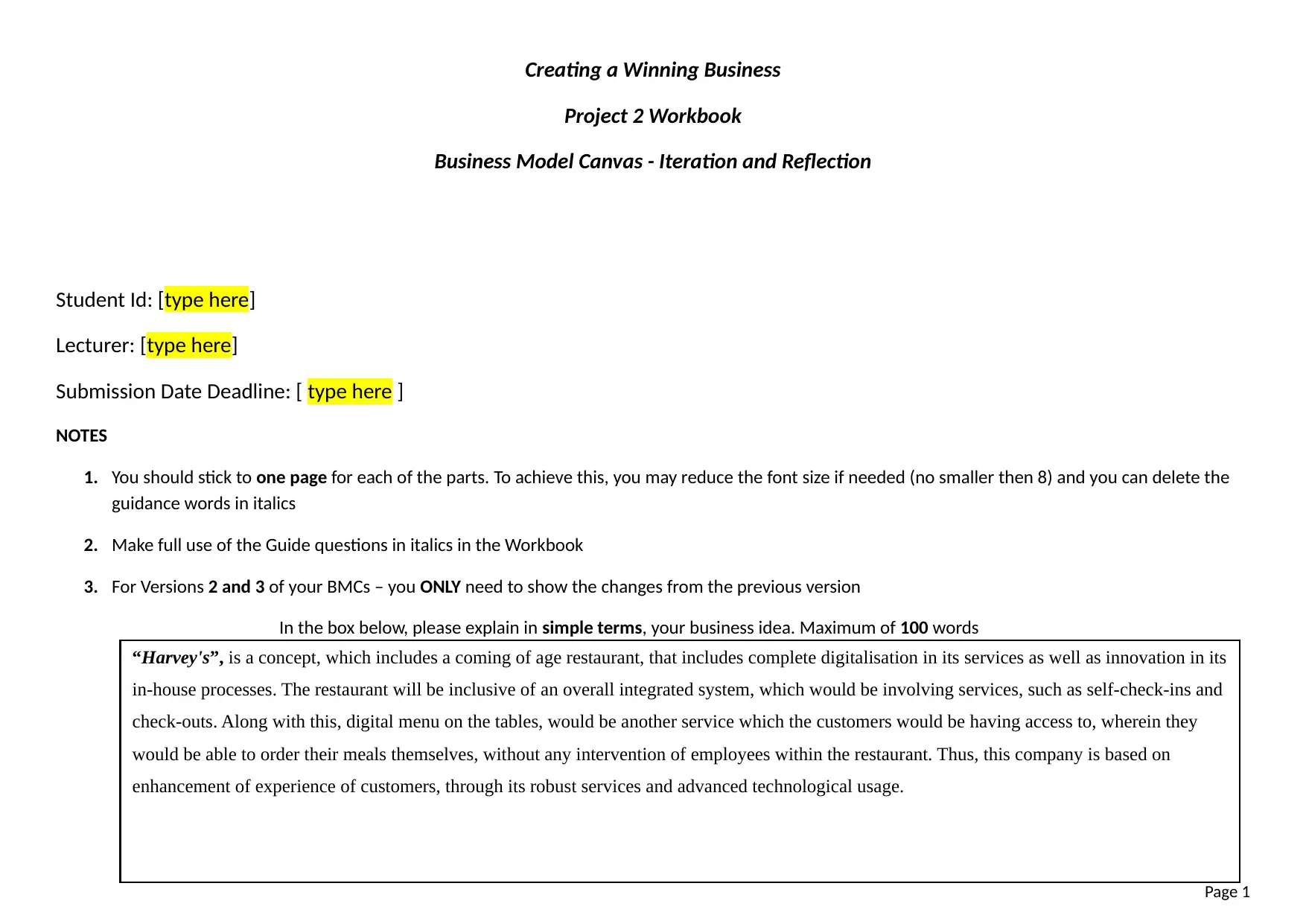
Creating a Winning Business
Project 2 Workbook
Business Model Canvas - Iteration and Reflection
Student Id: [type here]
Lecturer: [type here]
Submission Date Deadline: [ type here ]
NOTES
1. You should stick to one page for each of the parts. To achieve this, you may reduce the font size if needed (no smaller then 8) and you can delete the
guidance words in italics
2. Make full use of the Guide questions in italics in the Workbook
3. For Versions 2 and 3 of your BMCs – you ONLY need to show the changes from the previous version
In the box below, please explain in simple terms, your business idea. Maximum of 100 words
Page 1
“Harvey's”, is a concept, which includes a coming of age restaurant, that includes complete digitalisation in its services as well as innovation in its
in-house processes. The restaurant will be inclusive of an overall integrated system, which would be involving services, such as self-check-ins and
check-outs. Along with this, digital menu on the tables, would be another service which the customers would be having access to, wherein they
would be able to order their meals themselves, without any intervention of employees within the restaurant. Thus, this company is based on
enhancement of experience of customers, through its robust services and advanced technological usage.
Project 2 Workbook
Business Model Canvas - Iteration and Reflection
Student Id: [type here]
Lecturer: [type here]
Submission Date Deadline: [ type here ]
NOTES
1. You should stick to one page for each of the parts. To achieve this, you may reduce the font size if needed (no smaller then 8) and you can delete the
guidance words in italics
2. Make full use of the Guide questions in italics in the Workbook
3. For Versions 2 and 3 of your BMCs – you ONLY need to show the changes from the previous version
In the box below, please explain in simple terms, your business idea. Maximum of 100 words
Page 1
“Harvey's”, is a concept, which includes a coming of age restaurant, that includes complete digitalisation in its services as well as innovation in its
in-house processes. The restaurant will be inclusive of an overall integrated system, which would be involving services, such as self-check-ins and
check-outs. Along with this, digital menu on the tables, would be another service which the customers would be having access to, wherein they
would be able to order their meals themselves, without any intervention of employees within the restaurant. Thus, this company is based on
enhancement of experience of customers, through its robust services and advanced technological usage.
Paraphrase This Document
Need a fresh take? Get an instant paraphrase of this document with our AI Paraphraser
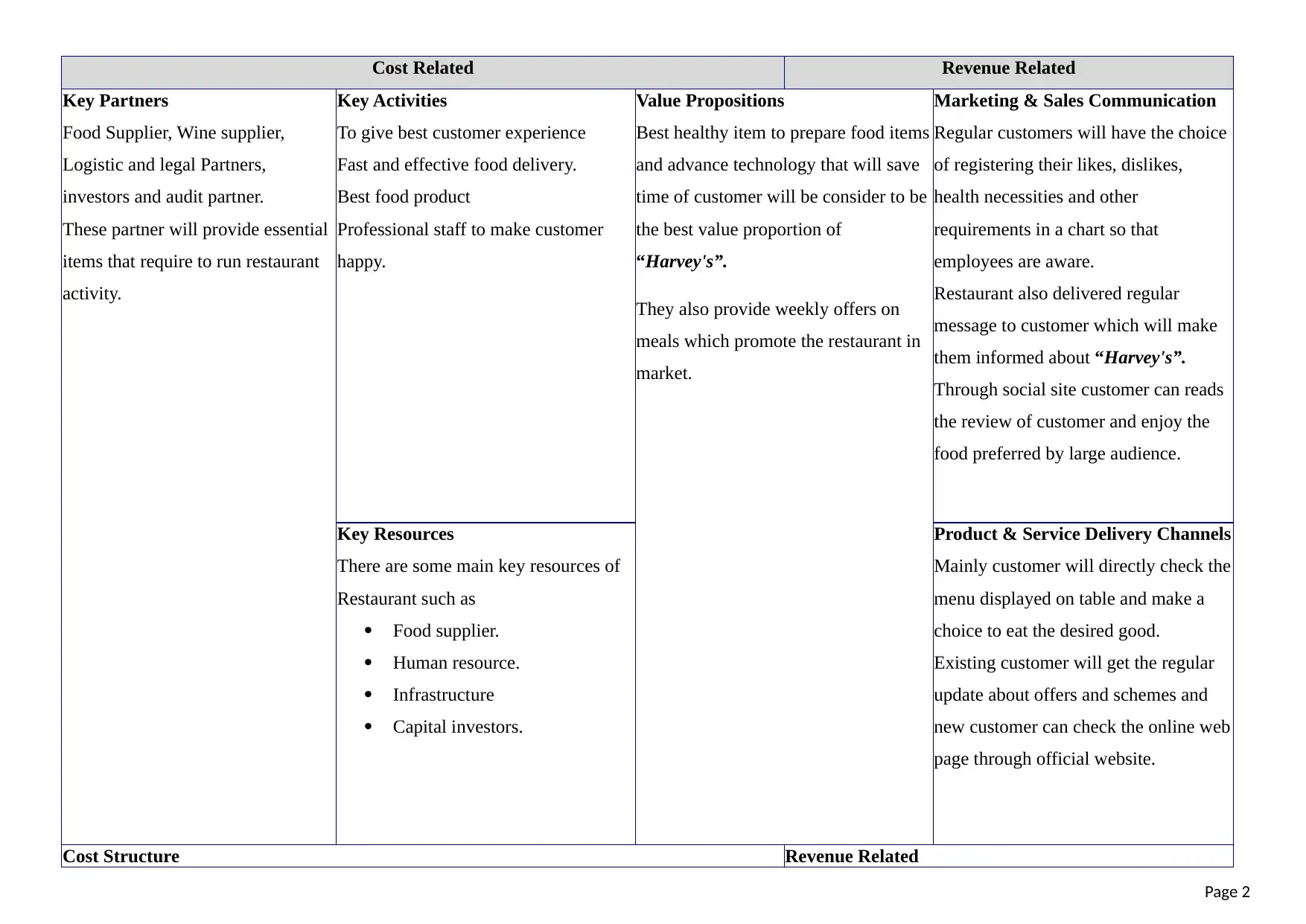
Cost Related Revenue Related
Key Partners
Food Supplier, Wine supplier,
Logistic and legal Partners,
investors and audit partner.
These partner will provide essential
items that require to run restaurant
activity.
Key Activities
To give best customer experience
Fast and effective food delivery.
Best food product
Professional staff to make customer
happy.
Value Propositions
Best healthy item to prepare food items
and advance technology that will save
time of customer will be consider to be
the best value proportion of
“Harvey's”.
They also provide weekly offers on
meals which promote the restaurant in
market.
Marketing & Sales Communication
Regular customers will have the choice
of registering their likes, dislikes,
health necessities and other
requirements in a chart so that
employees are aware.
Restaurant also delivered regular
message to customer which will make
them informed about “Harvey's”.
Through social site customer can reads
the review of customer and enjoy the
food preferred by large audience.
Key Resources
There are some main key resources of
Restaurant such as
Food supplier.
Human resource.
Infrastructure
Capital investors.
Product & Service Delivery Channels
Mainly customer will directly check the
menu displayed on table and make a
choice to eat the desired good.
Existing customer will get the regular
update about offers and schemes and
new customer can check the online web
page through official website.
Cost Structure Revenue Related
Page 2
Key Partners
Food Supplier, Wine supplier,
Logistic and legal Partners,
investors and audit partner.
These partner will provide essential
items that require to run restaurant
activity.
Key Activities
To give best customer experience
Fast and effective food delivery.
Best food product
Professional staff to make customer
happy.
Value Propositions
Best healthy item to prepare food items
and advance technology that will save
time of customer will be consider to be
the best value proportion of
“Harvey's”.
They also provide weekly offers on
meals which promote the restaurant in
market.
Marketing & Sales Communication
Regular customers will have the choice
of registering their likes, dislikes,
health necessities and other
requirements in a chart so that
employees are aware.
Restaurant also delivered regular
message to customer which will make
them informed about “Harvey's”.
Through social site customer can reads
the review of customer and enjoy the
food preferred by large audience.
Key Resources
There are some main key resources of
Restaurant such as
Food supplier.
Human resource.
Infrastructure
Capital investors.
Product & Service Delivery Channels
Mainly customer will directly check the
menu displayed on table and make a
choice to eat the desired good.
Existing customer will get the regular
update about offers and schemes and
new customer can check the online web
page through official website.
Cost Structure Revenue Related
Page 2
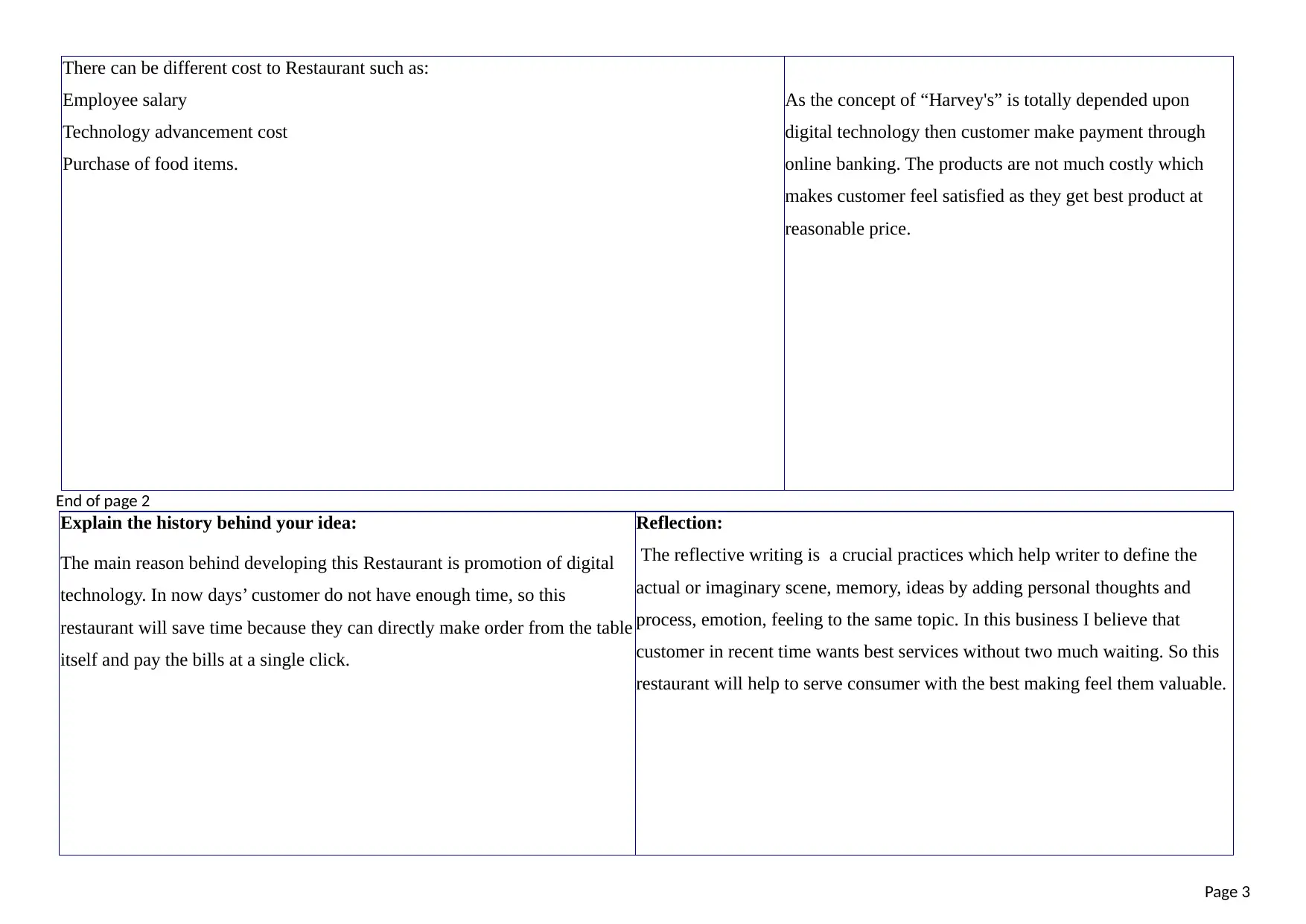
There can be different cost to Restaurant such as:
Employee salary
Technology advancement cost
Purchase of food items.
As the concept of “Harvey's” is totally depended upon
digital technology then customer make payment through
online banking. The products are not much costly which
makes customer feel satisfied as they get best product at
reasonable price.
End of page 2
Explain the history behind your idea:
The main reason behind developing this Restaurant is promotion of digital
technology. In now days’ customer do not have enough time, so this
restaurant will save time because they can directly make order from the table
itself and pay the bills at a single click.
Reflection:
The reflective writing is a crucial practices which help writer to define the
actual or imaginary scene, memory, ideas by adding personal thoughts and
process, emotion, feeling to the same topic. In this business I believe that
customer in recent time wants best services without two much waiting. So this
restaurant will help to serve consumer with the best making feel them valuable.
Page 3
Employee salary
Technology advancement cost
Purchase of food items.
As the concept of “Harvey's” is totally depended upon
digital technology then customer make payment through
online banking. The products are not much costly which
makes customer feel satisfied as they get best product at
reasonable price.
End of page 2
Explain the history behind your idea:
The main reason behind developing this Restaurant is promotion of digital
technology. In now days’ customer do not have enough time, so this
restaurant will save time because they can directly make order from the table
itself and pay the bills at a single click.
Reflection:
The reflective writing is a crucial practices which help writer to define the
actual or imaginary scene, memory, ideas by adding personal thoughts and
process, emotion, feeling to the same topic. In this business I believe that
customer in recent time wants best services without two much waiting. So this
restaurant will help to serve consumer with the best making feel them valuable.
Page 3
⊘ This is a preview!⊘
Do you want full access?
Subscribe today to unlock all pages.

Trusted by 1+ million students worldwide
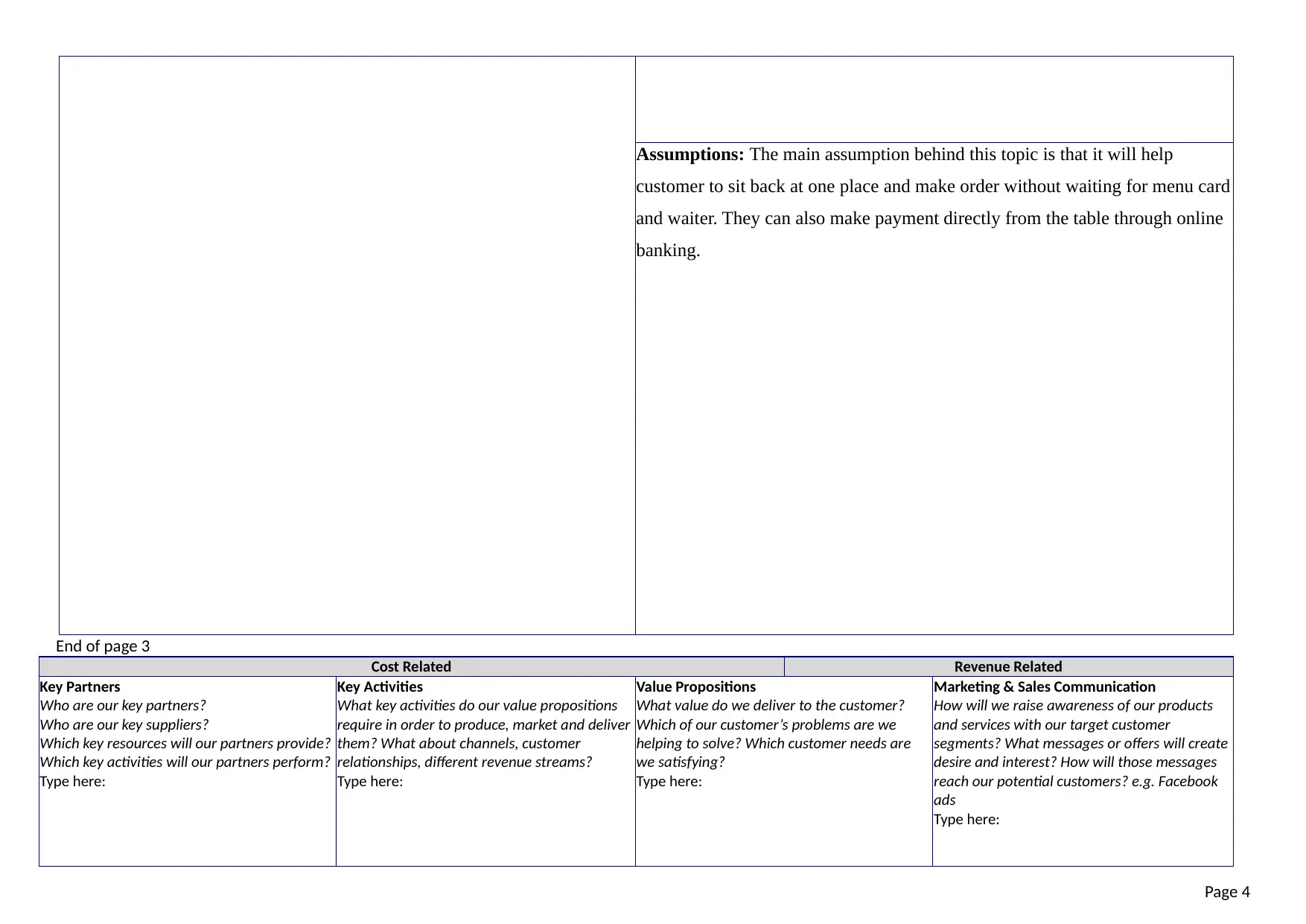
Assumptions: The main assumption behind this topic is that it will help
customer to sit back at one place and make order without waiting for menu card
and waiter. They can also make payment directly from the table through online
banking.
End of page 3
Cost Related Revenue Related
Key Partners
Who are our key partners?
Who are our key suppliers?
Which key resources will our partners provide?
Which key activities will our partners perform?
Type here:
Key Activities
What key activities do our value propositions
require in order to produce, market and deliver
them? What about channels, customer
relationships, different revenue streams?
Type here:
Value Propositions
What value do we deliver to the customer?
Which of our customer’s problems are we
helping to solve? Which customer needs are
we satisfying?
Type here:
Marketing & Sales Communication
How will we raise awareness of our products
and services with our target customer
segments? What messages or offers will create
desire and interest? How will those messages
reach our potential customers? e.g. Facebook
ads
Type here:
Page 4
customer to sit back at one place and make order without waiting for menu card
and waiter. They can also make payment directly from the table through online
banking.
End of page 3
Cost Related Revenue Related
Key Partners
Who are our key partners?
Who are our key suppliers?
Which key resources will our partners provide?
Which key activities will our partners perform?
Type here:
Key Activities
What key activities do our value propositions
require in order to produce, market and deliver
them? What about channels, customer
relationships, different revenue streams?
Type here:
Value Propositions
What value do we deliver to the customer?
Which of our customer’s problems are we
helping to solve? Which customer needs are
we satisfying?
Type here:
Marketing & Sales Communication
How will we raise awareness of our products
and services with our target customer
segments? What messages or offers will create
desire and interest? How will those messages
reach our potential customers? e.g. Facebook
ads
Type here:
Page 4
Paraphrase This Document
Need a fresh take? Get an instant paraphrase of this document with our AI Paraphraser
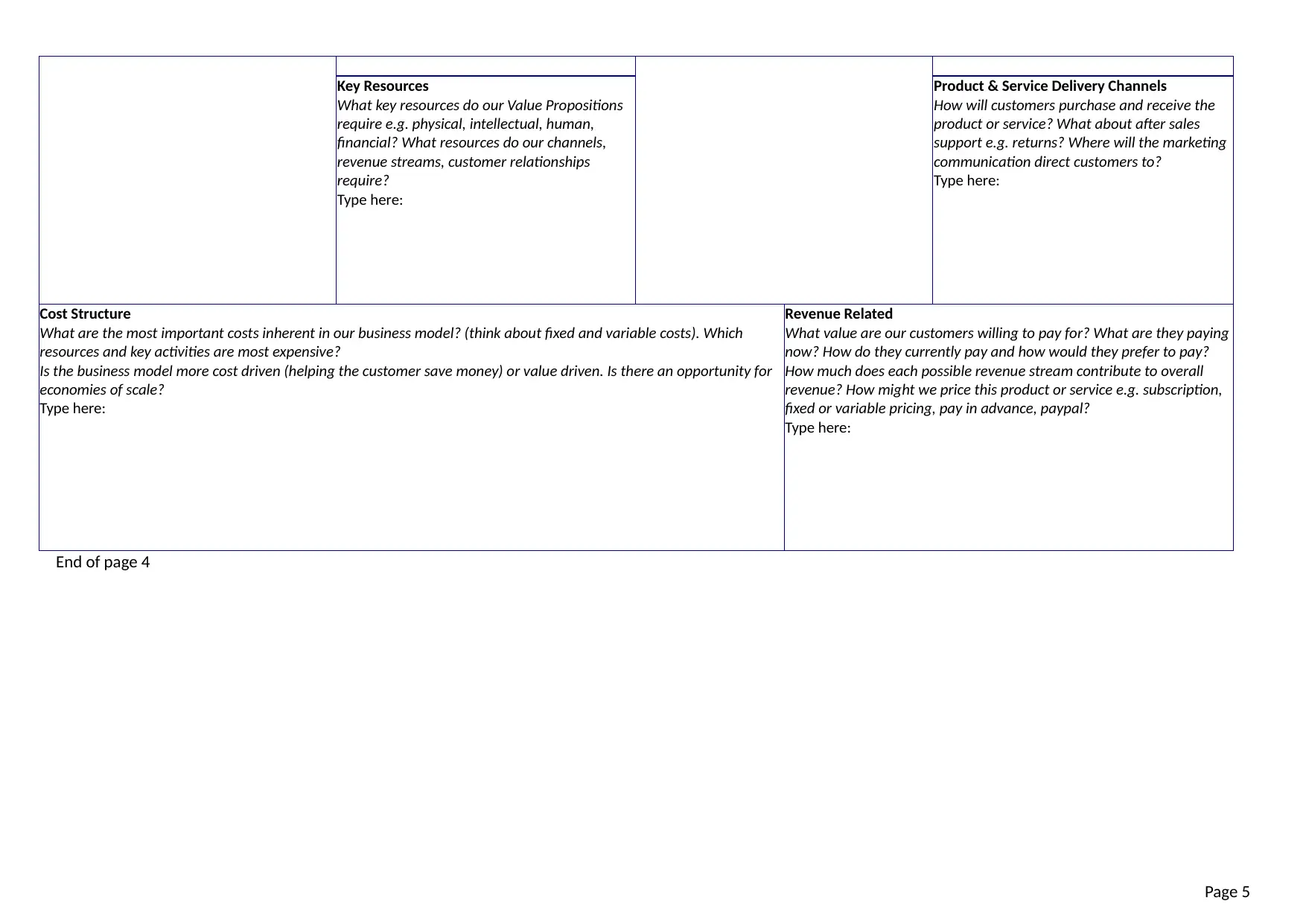
Key Resources
What key resources do our Value Propositions
require e.g. physical, intellectual, human,
financial? What resources do our channels,
revenue streams, customer relationships
require?
Type here:
Product & Service Delivery Channels
How will customers purchase and receive the
product or service? What about after sales
support e.g. returns? Where will the marketing
communication direct customers to?
Type here:
Cost Structure
What are the most important costs inherent in our business model? (think about fixed and variable costs). Which
resources and key activities are most expensive?
Is the business model more cost driven (helping the customer save money) or value driven. Is there an opportunity for
economies of scale?
Type here:
Revenue Related
What value are our customers willing to pay for? What are they paying
now? How do they currently pay and how would they prefer to pay?
How much does each possible revenue stream contribute to overall
revenue? How might we price this product or service e.g. subscription,
fixed or variable pricing, pay in advance, paypal?
Type here:
End of page 4
Page 5
What key resources do our Value Propositions
require e.g. physical, intellectual, human,
financial? What resources do our channels,
revenue streams, customer relationships
require?
Type here:
Product & Service Delivery Channels
How will customers purchase and receive the
product or service? What about after sales
support e.g. returns? Where will the marketing
communication direct customers to?
Type here:
Cost Structure
What are the most important costs inherent in our business model? (think about fixed and variable costs). Which
resources and key activities are most expensive?
Is the business model more cost driven (helping the customer save money) or value driven. Is there an opportunity for
economies of scale?
Type here:
Revenue Related
What value are our customers willing to pay for? What are they paying
now? How do they currently pay and how would they prefer to pay?
How much does each possible revenue stream contribute to overall
revenue? How might we price this product or service e.g. subscription,
fixed or variable pricing, pay in advance, paypal?
Type here:
End of page 4
Page 5
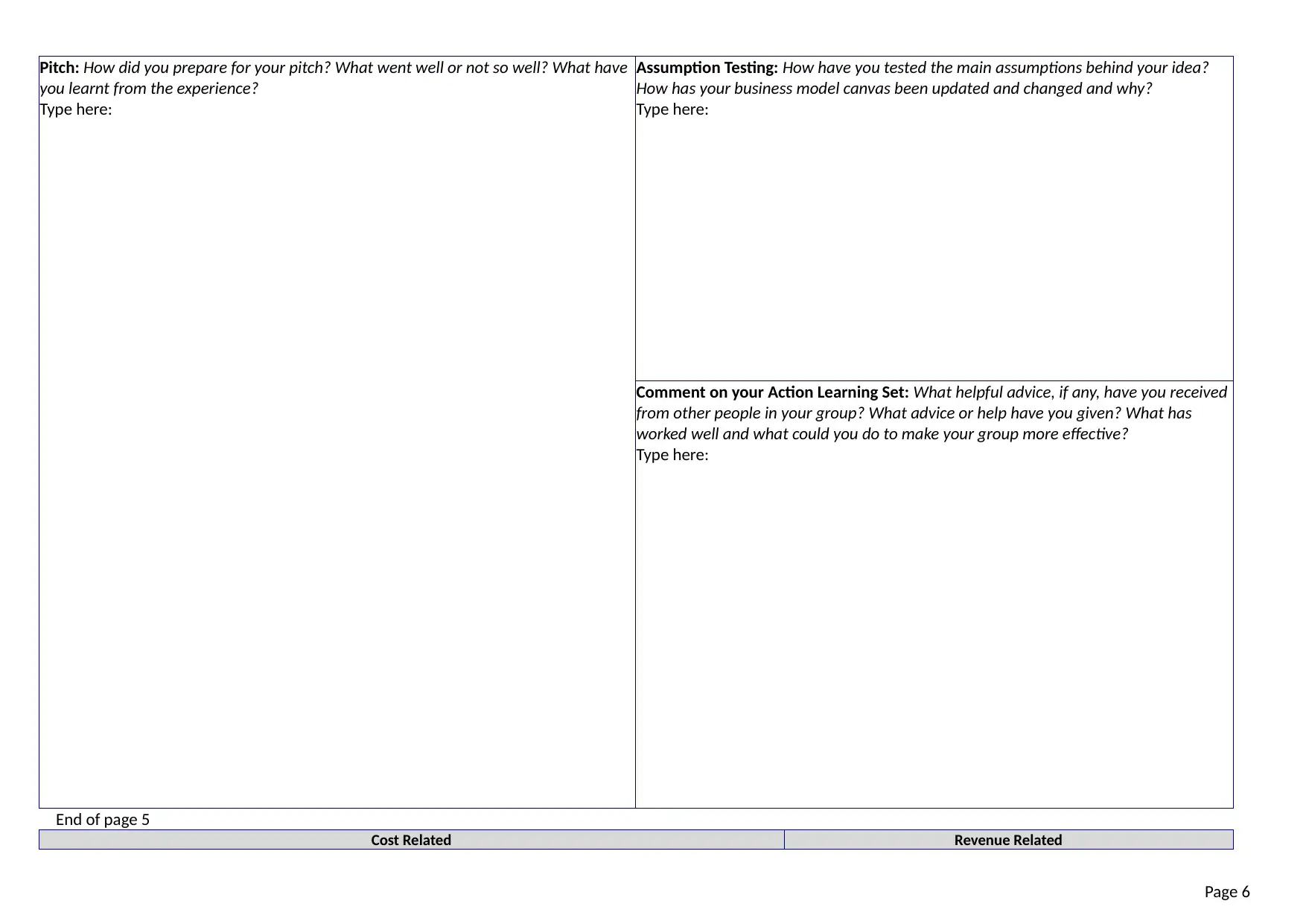
Pitch: How did you prepare for your pitch? What went well or not so well? What have
you learnt from the experience?
Type here:
Assumption Testing: How have you tested the main assumptions behind your idea?
How has your business model canvas been updated and changed and why?
Type here:
Comment on your Action Learning Set: What helpful advice, if any, have you received
from other people in your group? What advice or help have you given? What has
worked well and what could you do to make your group more effective?
Type here:
End of page 5
Cost Related Revenue Related
Page 6
you learnt from the experience?
Type here:
Assumption Testing: How have you tested the main assumptions behind your idea?
How has your business model canvas been updated and changed and why?
Type here:
Comment on your Action Learning Set: What helpful advice, if any, have you received
from other people in your group? What advice or help have you given? What has
worked well and what could you do to make your group more effective?
Type here:
End of page 5
Cost Related Revenue Related
Page 6
⊘ This is a preview!⊘
Do you want full access?
Subscribe today to unlock all pages.

Trusted by 1+ million students worldwide
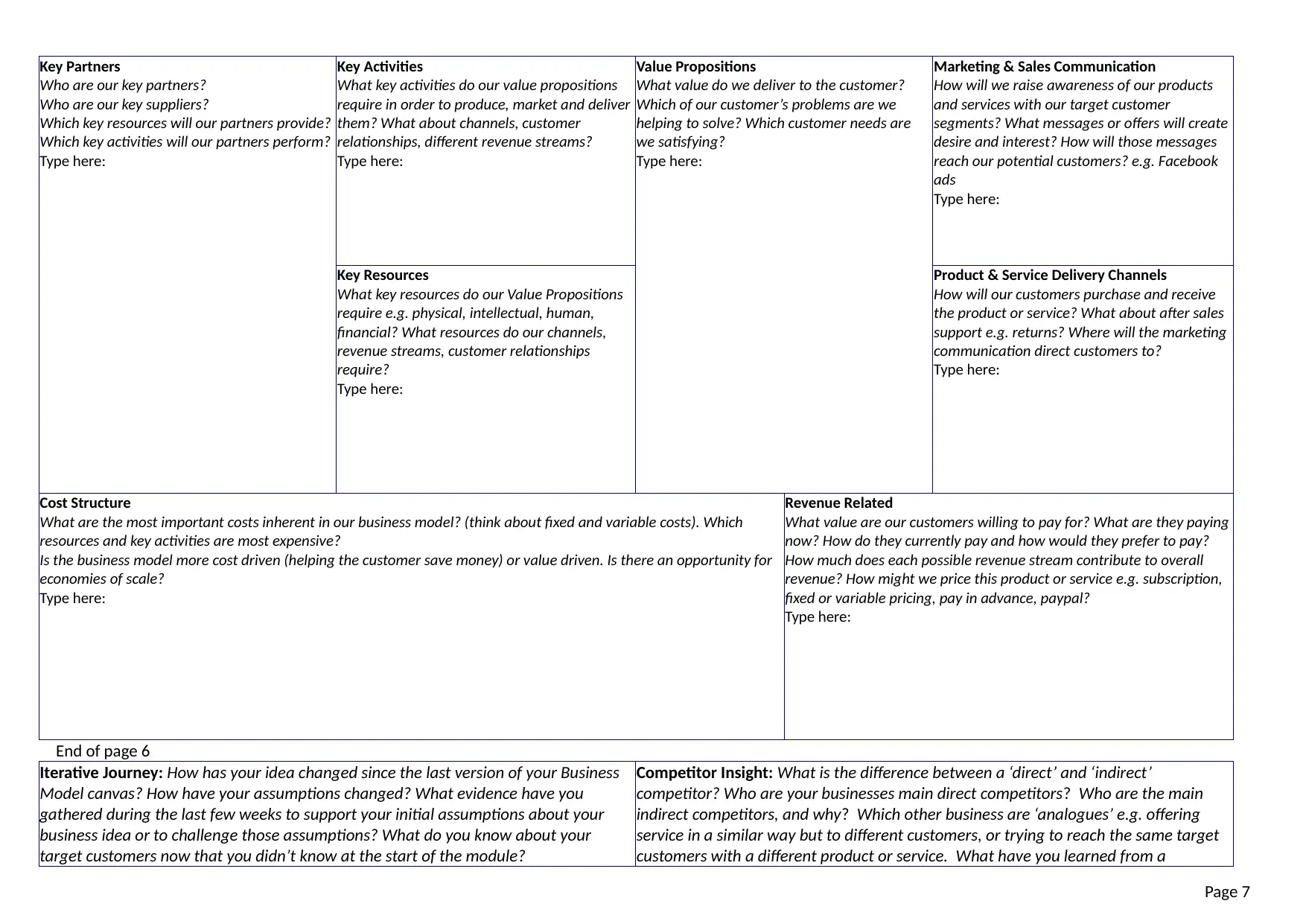
Key Partners
Who are our key partners?
Who are our key suppliers?
Which key resources will our partners provide?
Which key activities will our partners perform?
Type here:
Key Activities
What key activities do our value propositions
require in order to produce, market and deliver
them? What about channels, customer
relationships, different revenue streams?
Type here:
Value Propositions
What value do we deliver to the customer?
Which of our customer’s problems are we
helping to solve? Which customer needs are
we satisfying?
Type here:
Marketing & Sales Communication
How will we raise awareness of our products
and services with our target customer
segments? What messages or offers will create
desire and interest? How will those messages
reach our potential customers? e.g. Facebook
ads
Type here:
Key Resources
What key resources do our Value Propositions
require e.g. physical, intellectual, human,
financial? What resources do our channels,
revenue streams, customer relationships
require?
Type here:
Product & Service Delivery Channels
How will our customers purchase and receive
the product or service? What about after sales
support e.g. returns? Where will the marketing
communication direct customers to?
Type here:
Cost Structure
What are the most important costs inherent in our business model? (think about fixed and variable costs). Which
resources and key activities are most expensive?
Is the business model more cost driven (helping the customer save money) or value driven. Is there an opportunity for
economies of scale?
Type here:
Revenue Related
What value are our customers willing to pay for? What are they paying
now? How do they currently pay and how would they prefer to pay?
How much does each possible revenue stream contribute to overall
revenue? How might we price this product or service e.g. subscription,
fixed or variable pricing, pay in advance, paypal?
Type here:
End of page 6
Iterative Journey: How has your idea changed since the last version of your Business
Model canvas? How have your assumptions changed? What evidence have you
gathered during the last few weeks to support your initial assumptions about your
business idea or to challenge those assumptions? What do you know about your
target customers now that you didn’t know at the start of the module?
Competitor Insight: What is the difference between a ‘direct’ and ‘indirect’
competitor? Who are your businesses main direct competitors? Who are the main
indirect competitors, and why? Which other business are ‘analogues’ e.g. offering
service in a similar way but to different customers, or trying to reach the same target
customers with a different product or service. What have you learned from a
Page 7
Who are our key partners?
Who are our key suppliers?
Which key resources will our partners provide?
Which key activities will our partners perform?
Type here:
Key Activities
What key activities do our value propositions
require in order to produce, market and deliver
them? What about channels, customer
relationships, different revenue streams?
Type here:
Value Propositions
What value do we deliver to the customer?
Which of our customer’s problems are we
helping to solve? Which customer needs are
we satisfying?
Type here:
Marketing & Sales Communication
How will we raise awareness of our products
and services with our target customer
segments? What messages or offers will create
desire and interest? How will those messages
reach our potential customers? e.g. Facebook
ads
Type here:
Key Resources
What key resources do our Value Propositions
require e.g. physical, intellectual, human,
financial? What resources do our channels,
revenue streams, customer relationships
require?
Type here:
Product & Service Delivery Channels
How will our customers purchase and receive
the product or service? What about after sales
support e.g. returns? Where will the marketing
communication direct customers to?
Type here:
Cost Structure
What are the most important costs inherent in our business model? (think about fixed and variable costs). Which
resources and key activities are most expensive?
Is the business model more cost driven (helping the customer save money) or value driven. Is there an opportunity for
economies of scale?
Type here:
Revenue Related
What value are our customers willing to pay for? What are they paying
now? How do they currently pay and how would they prefer to pay?
How much does each possible revenue stream contribute to overall
revenue? How might we price this product or service e.g. subscription,
fixed or variable pricing, pay in advance, paypal?
Type here:
End of page 6
Iterative Journey: How has your idea changed since the last version of your Business
Model canvas? How have your assumptions changed? What evidence have you
gathered during the last few weeks to support your initial assumptions about your
business idea or to challenge those assumptions? What do you know about your
target customers now that you didn’t know at the start of the module?
Competitor Insight: What is the difference between a ‘direct’ and ‘indirect’
competitor? Who are your businesses main direct competitors? Who are the main
indirect competitors, and why? Which other business are ‘analogues’ e.g. offering
service in a similar way but to different customers, or trying to reach the same target
customers with a different product or service. What have you learned from a
Page 7
Paraphrase This Document
Need a fresh take? Get an instant paraphrase of this document with our AI Paraphraser
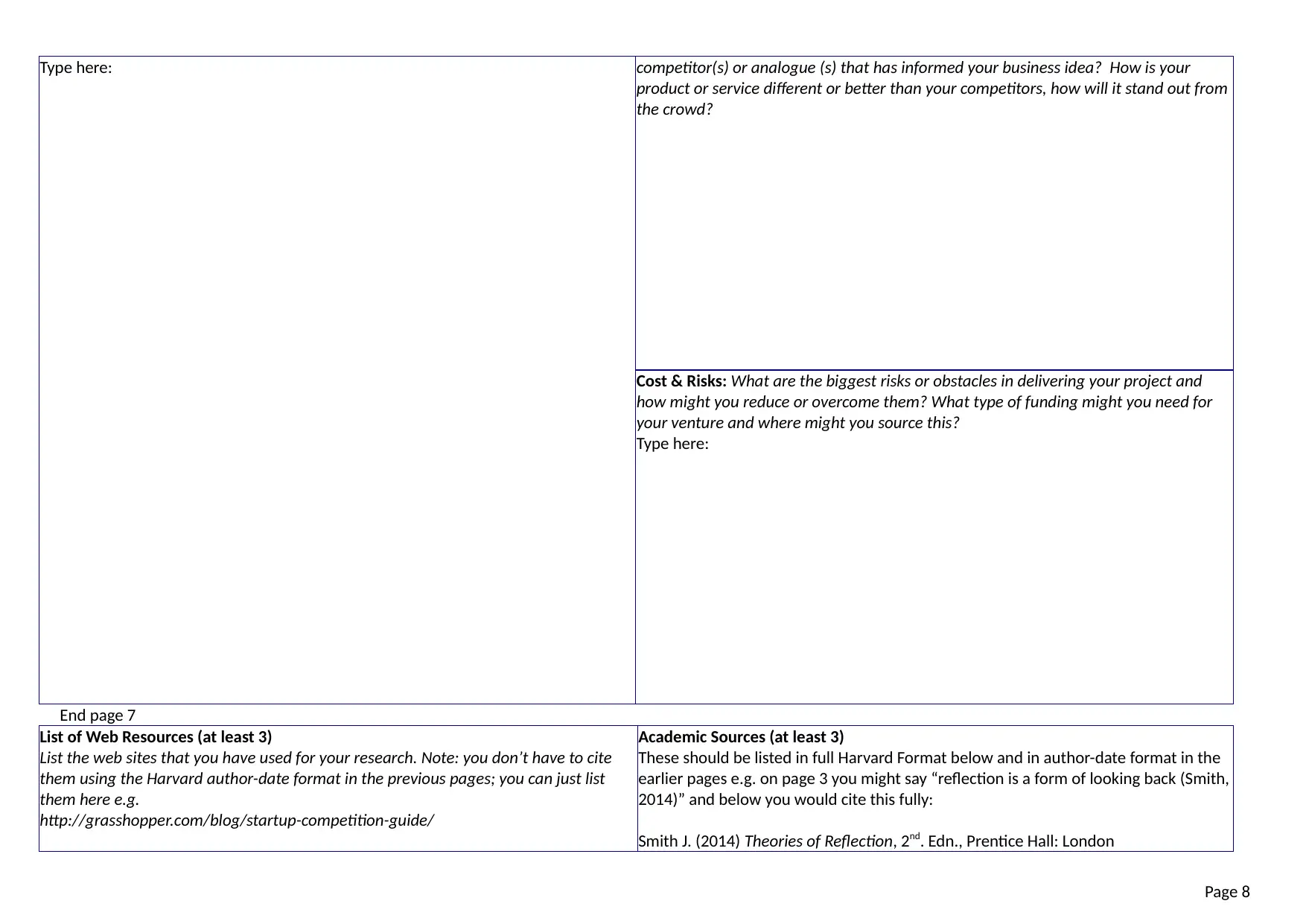
Type here: competitor(s) or analogue (s) that has informed your business idea? How is your
product or service different or better than your competitors, how will it stand out from
the crowd?
Cost & Risks: What are the biggest risks or obstacles in delivering your project and
how might you reduce or overcome them? What type of funding might you need for
your venture and where might you source this?
Type here:
End page 7
List of Web Resources (at least 3)
List the web sites that you have used for your research. Note: you don’t have to cite
them using the Harvard author-date format in the previous pages; you can just list
them here e.g.
http://grasshopper.com/blog/startup-competition-guide/
Academic Sources (at least 3)
These should be listed in full Harvard Format below and in author-date format in the
earlier pages e.g. on page 3 you might say “reflection is a form of looking back (Smith,
2014)” and below you would cite this fully:
Smith J. (2014) Theories of Reflection, 2nd. Edn., Prentice Hall: London
Page 8
product or service different or better than your competitors, how will it stand out from
the crowd?
Cost & Risks: What are the biggest risks or obstacles in delivering your project and
how might you reduce or overcome them? What type of funding might you need for
your venture and where might you source this?
Type here:
End page 7
List of Web Resources (at least 3)
List the web sites that you have used for your research. Note: you don’t have to cite
them using the Harvard author-date format in the previous pages; you can just list
them here e.g.
http://grasshopper.com/blog/startup-competition-guide/
Academic Sources (at least 3)
These should be listed in full Harvard Format below and in author-date format in the
earlier pages e.g. on page 3 you might say “reflection is a form of looking back (Smith,
2014)” and below you would cite this fully:
Smith J. (2014) Theories of Reflection, 2nd. Edn., Prentice Hall: London
Page 8
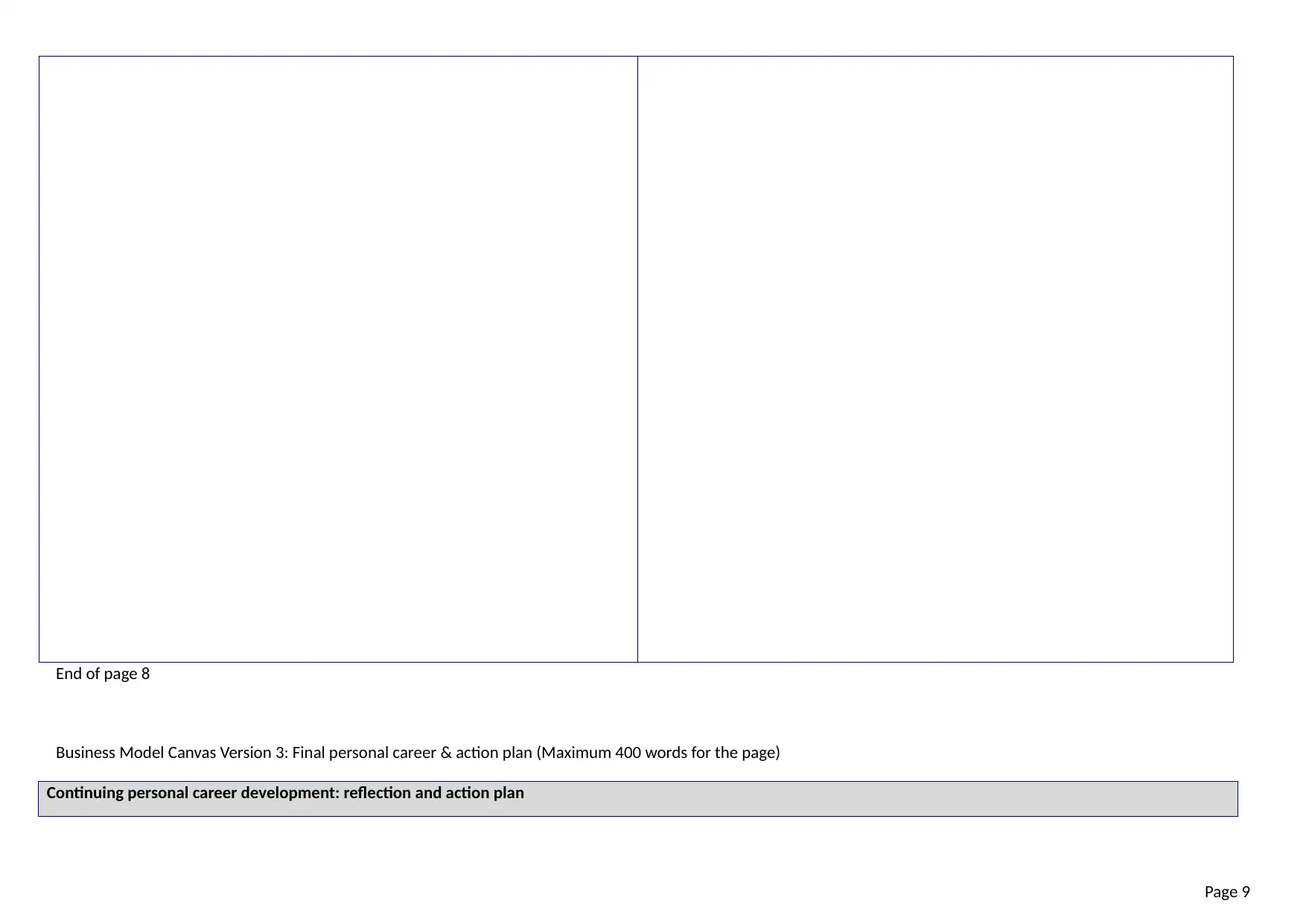
End of page 8
Business Model Canvas Version 3: Final personal career & action plan (Maximum 400 words for the page)
Continuing personal career development: reflection and action plan
Page 9
Business Model Canvas Version 3: Final personal career & action plan (Maximum 400 words for the page)
Continuing personal career development: reflection and action plan
Page 9
⊘ This is a preview!⊘
Do you want full access?
Subscribe today to unlock all pages.

Trusted by 1+ million students worldwide
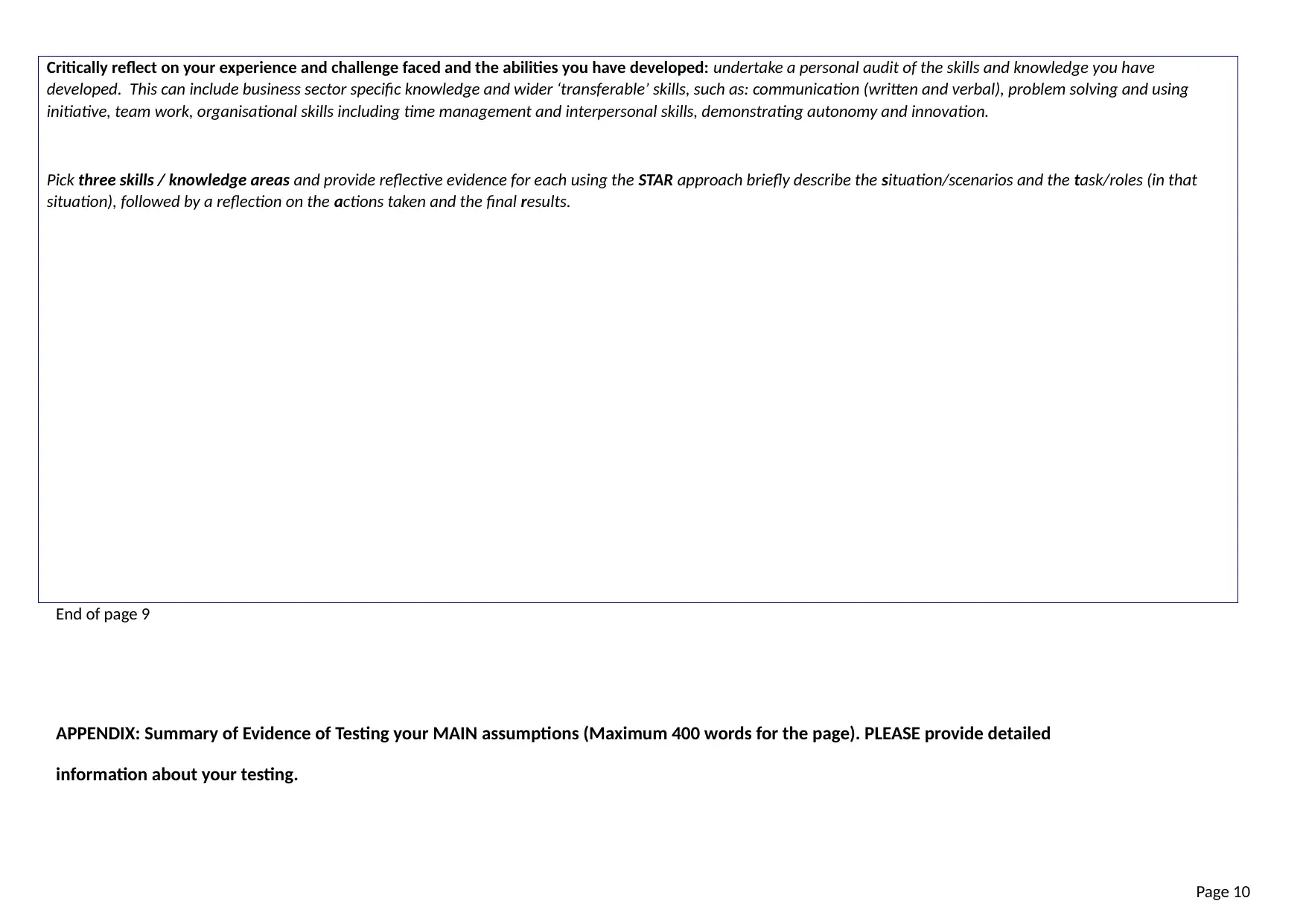
Critically reflect on your experience and challenge faced and the abilities you have developed: undertake a personal audit of the skills and knowledge you have
developed. This can include business sector specific knowledge and wider ‘transferable’ skills, such as: communication (written and verbal), problem solving and using
initiative, team work, organisational skills including time management and interpersonal skills, demonstrating autonomy and innovation.
Pick three skills / knowledge areas and provide reflective evidence for each using the STAR approach briefly describe the situation/scenarios and the task/roles (in that
situation), followed by a reflection on the actions taken and the final results.
End of page 9
APPENDIX: Summary of Evidence of Testing your MAIN assumptions (Maximum 400 words for the page). PLEASE provide detailed
information about your testing.
Page 10
developed. This can include business sector specific knowledge and wider ‘transferable’ skills, such as: communication (written and verbal), problem solving and using
initiative, team work, organisational skills including time management and interpersonal skills, demonstrating autonomy and innovation.
Pick three skills / knowledge areas and provide reflective evidence for each using the STAR approach briefly describe the situation/scenarios and the task/roles (in that
situation), followed by a reflection on the actions taken and the final results.
End of page 9
APPENDIX: Summary of Evidence of Testing your MAIN assumptions (Maximum 400 words for the page). PLEASE provide detailed
information about your testing.
Page 10
Paraphrase This Document
Need a fresh take? Get an instant paraphrase of this document with our AI Paraphraser
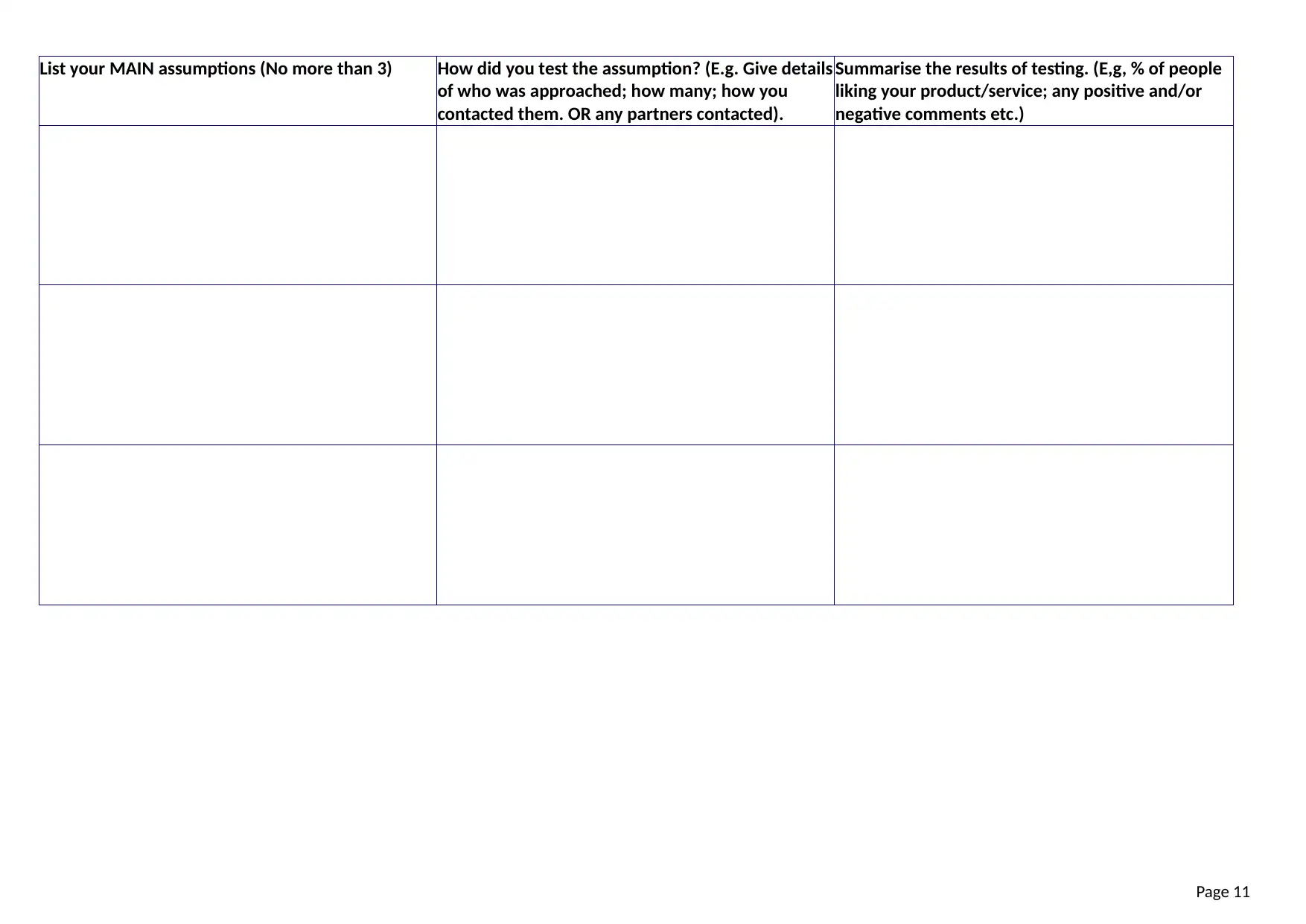
List your MAIN assumptions (No more than 3) How did you test the assumption? (E.g. Give details
of who was approached; how many; how you
contacted them. OR any partners contacted).
Summarise the results of testing. (E,g, % of people
liking your product/service; any positive and/or
negative comments etc.)
Page 11
of who was approached; how many; how you
contacted them. OR any partners contacted).
Summarise the results of testing. (E,g, % of people
liking your product/service; any positive and/or
negative comments etc.)
Page 11
1 out of 11
Related Documents
Your All-in-One AI-Powered Toolkit for Academic Success.
+13062052269
info@desklib.com
Available 24*7 on WhatsApp / Email
![[object Object]](/_next/static/media/star-bottom.7253800d.svg)
Unlock your academic potential
Copyright © 2020–2025 A2Z Services. All Rights Reserved. Developed and managed by ZUCOL.





